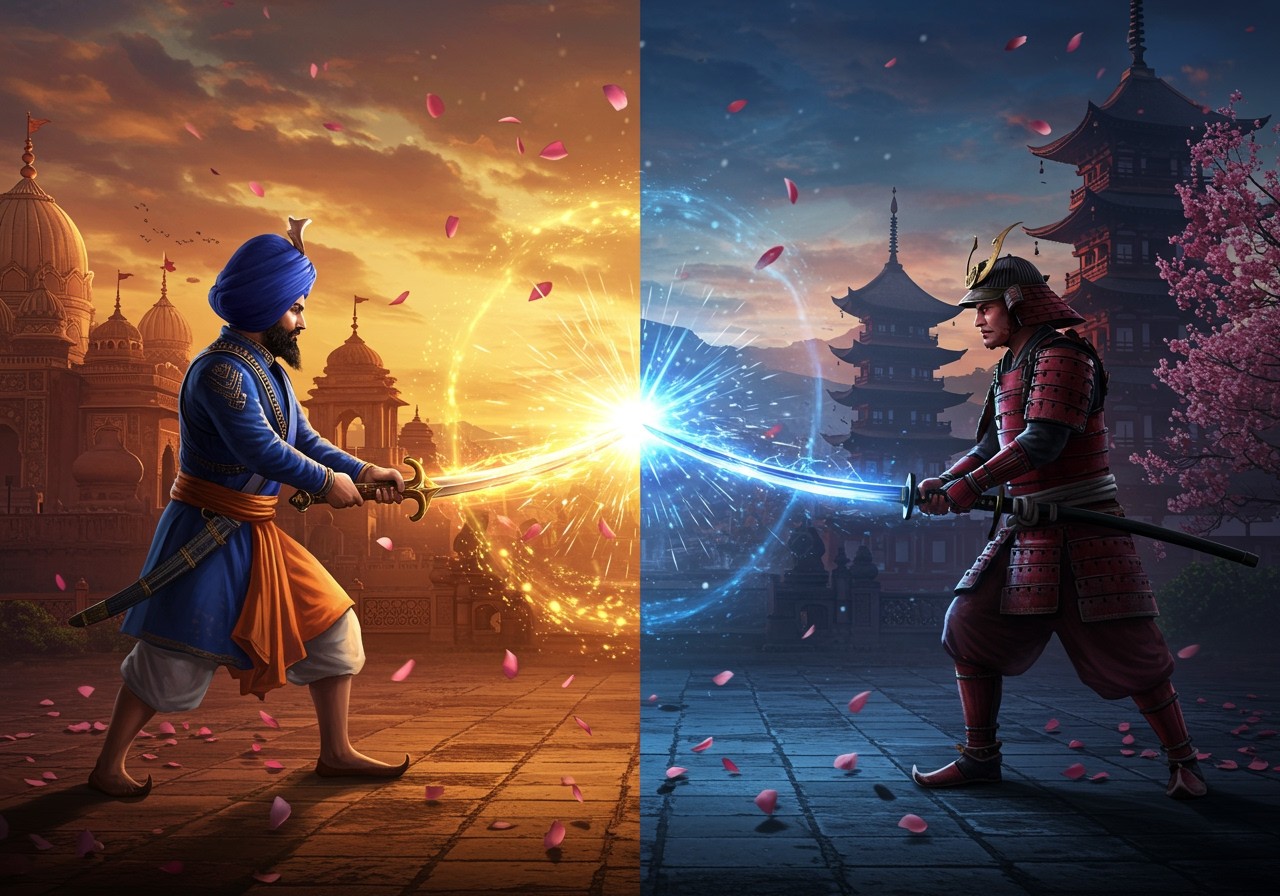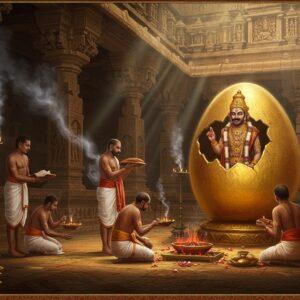
Namaste. Today, we delve into the captivating world of two iconic swords, each steeped in rich history and cultural significance: the Indian Khanda and the Japanese Katana. Join us as we explore their unique characteristics, historical journeys, and the profound cultural imprints they have left behind. This exploration resonates deeply with those who cherish tradition and appreciate the artistry of historical artifacts.
Unveiling the Majesty of the Khanda
The Khanda, a double-edged straight sword, holds a revered place in India’s martial heritage. With its characteristic broad blade, often widening towards the tip, and a distinctive basket hilt providing both offensive and defensive capabilities, the Khanda stands as a symbol of strength and valor. Ancient Indian warriors, particularly the valiant Rajputs and the courageous Sikhs, wielded the Khanda with pride and skill on the battlefield. In Indian culture, it embodies courage, righteousness, and the unwavering spirit of resistance, often featured in religious imagery, theatrical performances, and artistic depictions of India’s rich past. It’s a common weapon seen in Indian martial arts, showcasing its enduring legacy.
You can delve deeper into the fascinating history of the Sun Temples and the significance of Sun worship by exploring these insightful articles:
- Konark vs. Modhera: A Sun Temple Comparison – India’s Architectural Marvels
- Sun Worship in Hinduism: Exploring the Sun Temples’ Significance
Discovering the Elegance of the Katana
The Katana, a single-edged curved sword, is intrinsically linked to the samurai, the noble warriors of feudal Japan. Forged through the meticulous *tamahagane* process, involving the repeated folding and hammering of steel, the Katana’s blade possesses exceptional sharpness and remarkable durability. More than just a weapon, the Katana is considered the very soul of the samurai, an embodiment of honor, discipline, and unwavering loyalty. Its influence permeates Japanese martial arts such as Kendo and Iaido, and its elegant curve, complemented by intricate fittings, continues to captivate admirers worldwide. The Katana emerged later in history, evolving from earlier sword styles like the tachi and becoming integral to the samurai tradition.
A Comparative Glance: Blade Design and More
Juxtaposing the Khanda and Katana reveals intriguing contrasts in their blade designs, lengths, and intended uses. The Khanda, with its double-edged straight blade, is ideally suited for delivering powerful slashing blows. The Katana, distinguished by its curved edge, excels at executing precise cuts. The weight distribution and balance of each sword significantly influence its handling and dictate the combat techniques employed by its wielder. The creation of both swords involves distinct materials and specialized craftsmanship, showcasing the unique artistry and cultural nuances of their respective origins.
Tracing the Historical Threads
The Khanda and the Katana, each with its own distinct narrative, have evolved through different historical periods. The Khanda’s journey can be traced back to the Gupta period (320-550 AD) in the Indian subcontinent, deeply intertwined with ancient Indian warfare and revered by Rajput warrior clans. The Katana, on the other hand, emerged later in Japan, evolving from earlier sword types like the tachi, and becoming synonymous with the samurai of feudal Japan. Geopolitical forces and cultural exchanges have shaped their evolution, and the stories of legendary Rajput warriors and iconic samurai battles are intricately woven into their respective histories.
Cultural Resonance and Symbolic Significance
Transcending their martial applications, both the Khanda and the Katana hold profound cultural significance. The Khanda, a symbol of wisdom piercing through ignorance in Dharmic religions, embodies heroism, valor, and the unwavering spirit of resistance. In Sikhism, it stands as a sacred emblem of divine justice and sovereignty. The Katana, in Japan, is far more than a mere weapon; it’s a symbol of honor, precision, and the embodiment of the samurai tradition, reflecting the very spirit and cultural identity of Japan.
Modern Reverence and Enduring Legacy
In contemporary times, the Khanda and the Katana continue to exert their influence on modern weaponry and artistic expression. They are celebrated in museums and private collections, and there’s a resurgence of interest in the traditional sword-making techniques that brought them to life. Online platforms, catering to enthusiasts worldwide, offer access to authentic replicas and antique pieces. For those seeking to connect with their heritage, poojn.in offers a curated selection of sacred items, including ritual knives like the Tir Kathi and Trishul Kathi. These meticulously crafted pieces, imbued with deep spiritual significance, are perfect for those who value authenticity and tradition. You can explore our extensive collection of Panchmukhi Hanuman idols and other sacred items, bringing the blessings of tradition into your home.
A Deeper Dive into FAQs
Many of you have wondered about the key distinctions between the Khanda and Katana. The Khanda, originating from ancient India, stands out with its double-edged straight blade. The Katana, rising to prominence during Japan’s samurai era, is recognized for its single-edged curved design and its reputation for exceptional sharpness and swift cutting ability. Both swords carry profound cultural weight. The Khanda is revered as a symbol of strength and courage in Indian traditions, while the Katana, deeply entwined with the samurai ethos, signifies honor and unwavering discipline in Japanese culture.
Another common query revolves around the historical timelines of these two iconic swords. The Khanda boasts a more ancient lineage, tracing its roots back to the Indian subcontinent and figuring prominently in ancient warfare. The Katana, evolving from predecessors like the tachi, became a defining symbol of the samurai era.
Turning to their modern relevance, both swords maintain their presence in contemporary practices. The Khanda finds its place in martial arts and traditional ceremonies in India, while the Katana is featured in Japanese rituals and martial arts demonstrations. The distinct blade designs serve specific martial purposes. The Khanda’s broad, straight blade is crafted for delivering forceful strikes, whereas the Katana’s curved design facilitates swift, precise cuts.
For those interested in acquiring these remarkable pieces of history, both the Khanda and Katana are available for purchase online, often through specialized stores that focus on traditional and ritual items.
Concluding Thoughts
The Khanda and the Katana, each a masterpiece in its own right, stand as testaments to the artistic ingenuity and cultural values of their respective origins. The Khanda, with its robust form and deep-rooted symbolism, evokes the valor and spiritual depth of Indian warriors. The Katana, with its elegant curve and precise craftsmanship, embodies the honor and tradition of the Japanese samurai. Each sword possesses distinct strengths, from the Khanda’s powerful slashes to the Katana’s swift, precise cuts, reflecting the diverse martial philosophies and cultural narratives they carry. Whether it’s the Khanda’s embodiment of divine justice or the Katana’s representation of samurai honor, both swords continue to inspire reverence and pride. Appreciating these iconic blades means not only honoring their historical significance but also embracing the rich cultural tapestries they represent.
For further exploration into the rich tapestry of Indian deities and their significance, we invite you to delve into the stories of Lord Kartikeya and Lord Ganesha.


